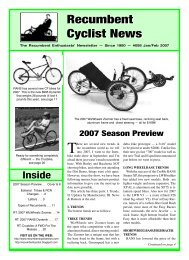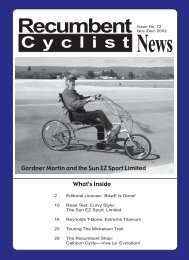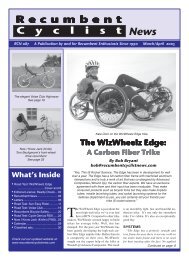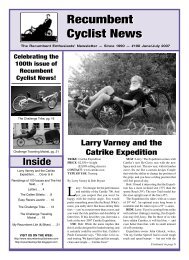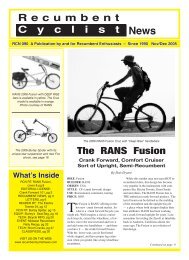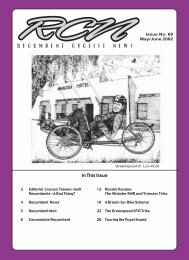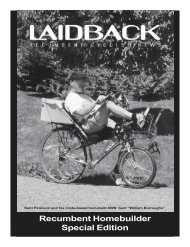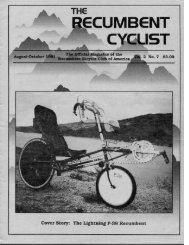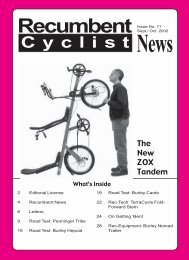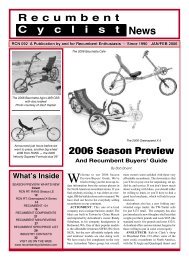C y c l i s t Recumbent - Steve Briggs
C y c l i s t Recumbent - Steve Briggs
C y c l i s t Recumbent - Steve Briggs
Create successful ePaper yourself
Turn your PDF publications into a flip-book with our unique Google optimized e-Paper software.
lighter-weight riders.<br />
The Pocket has an adjustable sliding boom<br />
which requires chain adjustments for each new<br />
rider. Perhaps Catrike should consider developing<br />
a demo chain idler which spring loads<br />
the chain and takes up additional chain slack<br />
for dealers and rental trikes who do frequent<br />
rider size adjustments. (Vision offered one).<br />
“The Pocket is certainly the quickest of the<br />
Catrikes and it is really not designed for highspeed<br />
handling.” — Paulo Camasmie, Catrike<br />
RCN Road Test:<br />
The Catrike Pocket<br />
A Short, narrow and light tadpole<br />
By Bob Bryant<br />
bob@recumbentcyclistnews.com<br />
“The Catrike Pocket is a fun, compact, recreational tricycle with an upright and<br />
comfortable seat. The Pocket can also be used for short-track racing. The Pocket is a<br />
high quality trike that fits nearly any budget — and it is hand crafted in the USA.”<br />
— Catrike<br />
TRIKE: Pocket<br />
BUILDER: Catrike<br />
ORIGIN: Winter Garden, FL, USA<br />
STYLE: Micro tadpole trike<br />
USE: Recreation and short track racing<br />
PRICE: $1,500<br />
“All riders — regardless of budget — should<br />
be able to afford a light and pleasant trike.”<br />
— Paulo Camasmie, Catrike<br />
The Catrike Pocket is the smallest, shortest<br />
(4” shorter wheelbase than a Road<br />
model), lightest and narrowest trike<br />
we’ve ever had roll through the front door here<br />
at RCN. This petite little trike weighs a scant<br />
27 pounds and is a dream come true for smaller<br />
riders who don’t want to lift a 40-pound trike<br />
into the minivan. Another benefit is that the<br />
Pocket even fits us non-petite-sized folks.<br />
COMFORT<br />
The Catrike seat is part of its space frame,<br />
and is about as simple as can be. The seat back<br />
isn’t very tall (this is a tiny trike) which became<br />
immediately apparent when I sat my 6’<br />
body down on the seat. There is no lumbar<br />
bend, but about 30% of the time lumbar bends<br />
hit me in the wrong spot anyway. I may try a<br />
strap on car-type lumbar pillow, but so far don’t<br />
really need it.<br />
The seat back recline angle is 45º (the 2004<br />
Road models is 43º), and feels more laid back<br />
than it really is. The mesh is simple, breathable<br />
and comfortable. The only downside is<br />
that you can feel the seat/frame tubes. The<br />
straps are short and installing them was a<br />
chore. Once they stretched out, the length is<br />
fine. We didn’t order the optional neck rest,<br />
but we should have.<br />
FIT<br />
The Pocket will accept pilots with up to a<br />
45” x-seam. At 6’ tall, a 33” inseam and a 44.5”<br />
x-seam, I was definitely at the end of the range<br />
for this trike. This trike was fine for everyone<br />
else in my family, and they all loved riding it.<br />
The Pocket is ideally suited for shorter and<br />
RIDE<br />
This little trike feels ultra-light, and it takes<br />
minimal effort to propel. The Pocket quickly<br />
accelerates up to bike trail speed, where it feels<br />
the most comfortable.<br />
While I could fit this trike just fine, the<br />
Pocket had a definite split personality with me<br />
onboard. Over the very smooth and flat new<br />
pavement in my neighborhood, the Pocket<br />
behaved like an autocross race car, zipping<br />
everywhere and turning on a dime. It was very<br />
predictable and awesome fun. When I ventured<br />
out onto the local roads, with their rutted and<br />
aged pavement, off-camber turns and fast<br />
down hills, the Pocket’s handling became<br />
twitchier as my speed approached 20 mph.<br />
I experienced some difficulty in doing a onehanded<br />
brake and turn signal from 15 mph. I<br />
had to slow way down to accomplish this maneuver.<br />
There is also noticeable brake steer,<br />
which is to be expected from this narrow, responsive<br />
direct-steering trike with strong disc<br />
brakes. Planned and practiced fluid movements<br />
will be required if you want to ride this trike<br />
over rough roads or hilly terrain. This did not<br />
seem to be an issue on flat smooth roads or<br />
paved bike trails.<br />
Another minor concern was the twist-grip<br />
shifting motion of the SRAM MRX shifters.<br />
Bar-ends are vastly superior for trikes. The<br />
forward-backward shifting motion requires<br />
less effort and is easier to coordinate with steering<br />
movements than twist grips.<br />
The Pocket ride was not as bumpy as I would<br />
have expected from a tiny-wheeled trike with<br />
an aluminum frame. The handling is actually<br />
very good, but this is the shortest wheelbase<br />
trike made. It will be best for smooth bike trails<br />
with a more size-appropriate rider.<br />
I asked Catrike’s Paulo Camasmie about the<br />
Pocket’s handling. Here is what he said: “The<br />
wheelbase is very short. So it would take some<br />
getting used to do one-handed maneuvers at<br />
speed. If you are going to brake the right wheel,<br />
you want to apply pressure forward on the right<br />
handlebar. The wheel will try to steer to the<br />
right so you are in fact compensating by turning<br />
to the left. This trike has very little brake<br />
steer and is maybe only noticeable with a lot<br />
of load and at high speed, so we are talking<br />
about a slight bit of compensation here.<br />
16 <strong>Recumbent</strong> Cyclist News



